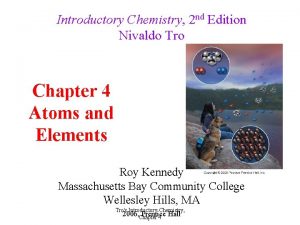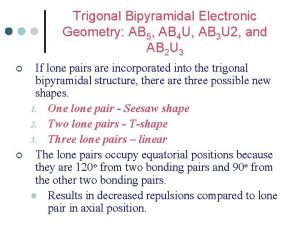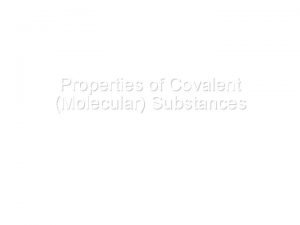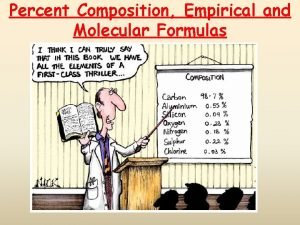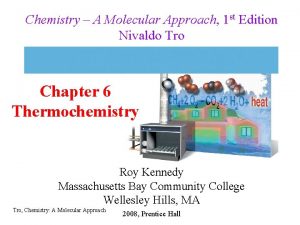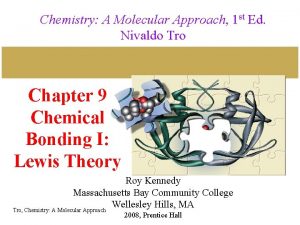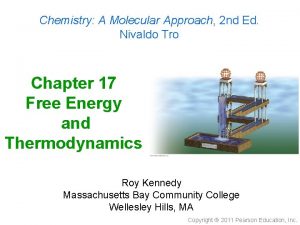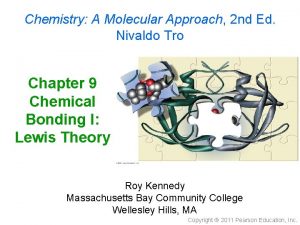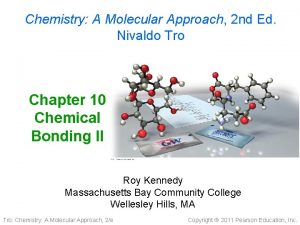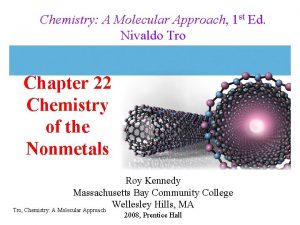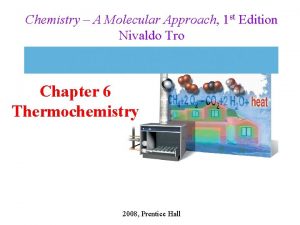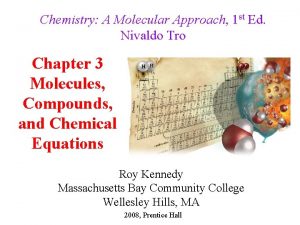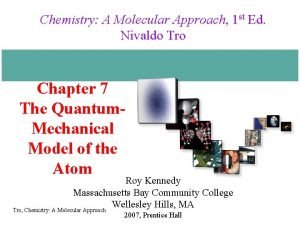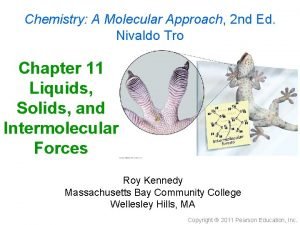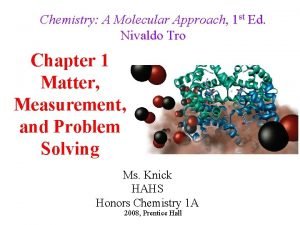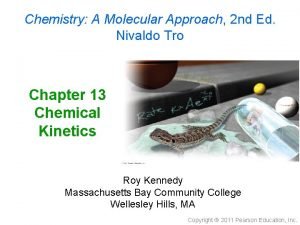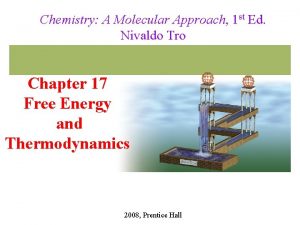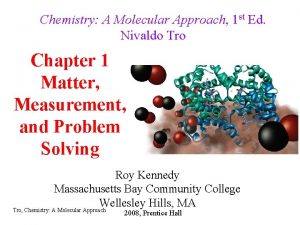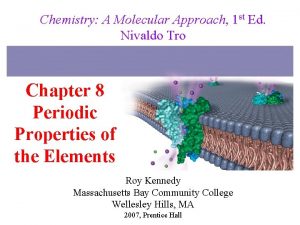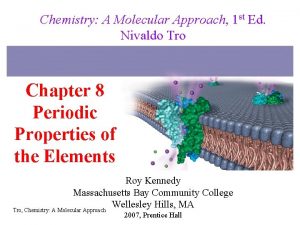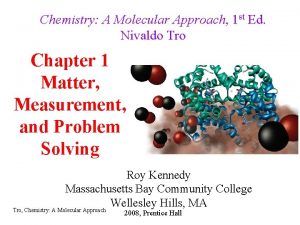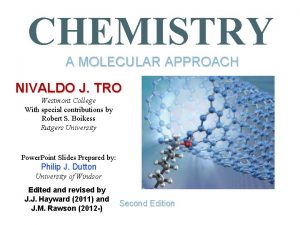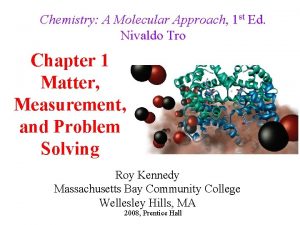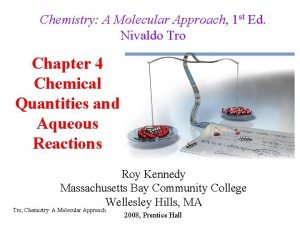Chemistry A Molecular Approach 1 st Ed Nivaldo























![[Co(en)3]3+ Optical Isomers • optical isomers are stereoisomers that are nonsuperimposable mirror images of [Co(en)3]3+ Optical Isomers • optical isomers are stereoisomers that are nonsuperimposable mirror images of](https://slidetodoc.com/presentation_image/29ec0053cb8c44f6eeda26a1fda59542/image-24.jpg)
![Ex 24. 7 – Determine if the cis-trans isomers of [Co(en)2 Cl 2]+ are Ex 24. 7 – Determine if the cis-trans isomers of [Co(en)2 Cl 2]+ are](https://slidetodoc.com/presentation_image/29ec0053cb8c44f6eeda26a1fda59542/image-25.jpg)
















- Slides: 41

Chemistry: A Molecular Approach, 1 st Ed. Nivaldo Tro Chapter 24 Transition Metals and Coordination Compounds Roy Kennedy Massachusetts Bay Community College Wellesley Hills, MA Tro, Chemistry: A Molecular Approach 2007, Prentice Hall

Gemstones • the colors of rubies and emeralds are both due to the presence of Cr 3+ ions – the difference lies in the crystal hosting the ion Some Al 3+ ions in Al 2 O 3 are replaced by Cr 3+ Tro, Chemistry: A Molecular Approach Some Al 3+ ions in Be 3 Al 2(Si. O 3)6 are replaced by Cr 3+ 2

Properties and Electron Configuration of Transition Metals • the properties of the transition metals are similar to each other ü and very different tot he properties of the main group metals ü high melting points, high densities, moderate to very hard, and very good electrical conductors • in general, the transition metals have two valence electrons – we are filling the d orbitals in the shell below the valence ü Group 1 B and some others have 1 valence electron due to “promotion” of an electron into the d sublevel to fill it ü form ions by losing the ns electrons first, then the (n – 1)d Tro, Chemistry: A Molecular Approach 3

Atomic Size • the atomic radii of all the transition metals are very similar üsmall increase in size down a column Tro, Chemistry: A Molecular Approach 4

Ionization Energy • the first ionization • energy of the transition metals slowly increases across a series third transition series slightly higher 1 st IE ütrend opposite to main group elements Tro, Chemistry: A Molecular Approach 5

Electronegativity • the electronegativity of the transition metals slowly increases across a series ü except for last element in the series • electronegativity slightly increases down the column ü trend opposite to main group elements Tro, Chemistry: A Molecular Approach 6

Oxidation States • often exhibit multiple oxidation states • vary by 1 • highest oxidation state is group number for 3 B to 7 B Tro, Chemistry: A Molecular Approach 7

Coordination Compounds • when a complex ion combines with counterions to • • make a neutral compound it is called a coordination compound the primary valence is the oxidation number of the metal the secondary valence is the number of ligands bonded to the metal ü coordination number • coordination number range from 2 to 12, with the most common being 6 and 4 Co. Cl 3 6 H 2 O = [Co(H 2 O)6]Cl 3 Tro, Chemistry: A Molecular Approach 8

Coordination Compound Tro, Chemistry: A Molecular Approach 9

Complex Ion Formation • complex ion formation is a type of Lewis acid • base reaction a bond that forms when the pair of electrons is donated by one atom is called a coordinate covalent bond Tro, Chemistry: A Molecular Approach 10

Ligands with Extra Teeth • some ligands can form more than one coordinate covalent bond with the metal atom ülone pairs on different atoms that are separate enough so that both can reach the metal • chelate is a complex ion containing a multidentate ligand üligand is called the chelating agent Tro, Chemistry: A Molecular Approach 11

Tro, Chemistry: A Molecular Approach 12

EDTA a Polydentate Ligand Tro, Chemistry: A Molecular Approach 13

Complex Ions with Polydentate Ligands Tro, Chemistry: A Molecular Approach 14

Geometries in Complex Ions Tro, Chemistry: A Molecular Approach 15

Naming Coordination Compounds 1) determine the name of the noncomplex ion 2) determine the ligand names and list them in 3) 4) alphabetical order determine the name of the metal cation name the complex ion by: 1) name each ligand alphabetically, adding a prefix in front of each ligand to indicate the number found in the complex ion 2) follow with the name of the metal cation 5) write the name of the cation followed by the name of the anion Tro, Chemistry: A Molecular Approach 16

Common Ligands Tro, Chemistry: A Molecular Approach 17

Common Metals found in Anionic Complex Ions Tro, Chemistry: A Molecular Approach 18

Isomers • Structural isomers are molecules that have the • same number and type of atoms, but they are attached in a different order Stereoisomers are molecules that have the same number and type of atoms, and that are attached in the same order, but the atoms or groups of atoms point in a different spatial direction Tro, Chemistry: A Molecular Approach 19

20

Linkage Isomers Tro, Chemistry: A Molecular Approach 21

Geometric Isomers • geometric isomers are stereoisomers that differ in the spatial orientation of ligands • cis-trans fac-mer isomerismininoctahedralcomplexes square-planar complexes MA MAMA B 322 B 2 34 B Tro, Chemistry: A Molecular Approach 22

Ex. 24. 5 – Draw the structures and label the type for all isomers of [Co(en)2 Cl 2]+ the ethylenediamine ligand (en = H 2 NCH 2 NH 2) is bidentate each Cl ligand is monodentate octahedral MA 4 B 2 Tro, Chemistry: A Molecular Approach 23
![Coen33 Optical Isomers optical isomers are stereoisomers that are nonsuperimposable mirror images of [Co(en)3]3+ Optical Isomers • optical isomers are stereoisomers that are nonsuperimposable mirror images of](https://slidetodoc.com/presentation_image/29ec0053cb8c44f6eeda26a1fda59542/image-24.jpg)
[Co(en)3]3+ Optical Isomers • optical isomers are stereoisomers that are nonsuperimposable mirror images of each other Tro, Chemistry: A Molecular Approach 24
![Ex 24 7 Determine if the cistrans isomers of Coen2 Cl 2 are Ex 24. 7 – Determine if the cis-trans isomers of [Co(en)2 Cl 2]+ are](https://slidetodoc.com/presentation_image/29ec0053cb8c44f6eeda26a1fda59542/image-25.jpg)
Ex 24. 7 – Determine if the cis-trans isomers of [Co(en)2 Cl 2]+ are optically active • draw the mirror image of the given isomer and check to see if they are superimposable cis trans isomer mirroridentical image istononsuperimposable its mirror image noopticalisomers isomerism Tro, Chemistry: A Molecular Approach 25

Bonding in Coordination Compounds Valence Bond Theory • bonding take place when the filled atomic • orbital on the ligand overlaps an empty atomic orbital on the metal ion explain geometries well, but doesn’t explain color or magnetic properties Tro, Chemistry: A Molecular Approach 26

Tro, Chemistry: A Molecular Approach 27

Bonding in Coordination Compounds Crystal Field Theory • bonds form due to the attraction of the electrons on the • • • ligand for the charge on the metal cation electrons on the ligands repel electrons in the unhybridized d orbitals of the metal ion the result is the energies of orbitals the d sublevel are split the difference in energy depends the complex and kinds of ligands ü crystal field splitting energy ü strong field splitting and weak field splitting Tro, Chemistry: A Molecular Approach 28

Splitting of d Orbital Energies due to Ligands in a Octahedral Complex Tro, Chemistry: A Molecular Approach 29

Strong and Weak Field Splitting Tro, Chemistry: A Molecular Approach 30

Complex Ion Color • the observed color is the complimentary color of the one that is absorbed Tro, Chemistry: A Molecular Approach 31

Complex Ion Color and Crystal Field Strength • the colors of complex ions are due to electronic • transitions between the split d sublevel orbitals the wavelength of maximum absorbance can be used to determine the size of the energy gap between the split d sublevel orbitals Ephoton = hc/l = D Tro, Chemistry: A Molecular Approach 32

Ligand Crystal Field Strength • the strength of the crystal field depends in large part on the ligands üstrong field ligands include: CN─ > NO 2─ > en > NH 3 üweak field ligands include H 2 O > OH─ > F─ > Cl─ > Br─ > I─ • crystal field strength increases as the charge on the metal cation increases Tro, Chemistry: A Molecular Approach 33

Magnetic Properties and Crystal Field Strength • the electron configuration of the metal ion with split d • • orbitals depends on the strength of the crystal field the 4 th and 5 th electrons will go into the higher energy dx 2 -y 2 and dz 2 if the field is weak and the energy gap is small – leading to unpaired electrons and a paramagnetic complex the 4 th thru 6 th electrons will pair the electrons in the dxy, dyz and dxz if the field is strong and the energy gap is large – leading to paired electrons and a diamagnetic complex Tro, Chemistry: A Molecular Approach 34

Low Spin & High Spin Complexes diamagnetic paramagnetic low-spin complex high-spin complex only electron configurations d 4, d 5, d 6, or d 7 can have low or high spin Tro, Chemistry: A Molecular Approach 35

Tetrahedral Geometry and Crystal Field Splitting • because the ligand approach interacts more • strongly with the planar orbitals in the tetrahedral geometry, their energies are raised most high-spin complexes Tro, Chemistry: A Molecular Approach 36

Square Planar Geometry and Crystal Field Splitting • d 8 metals • the most complex splitting pattern • most are low-spin complexes Tro, Chemistry: A Molecular Approach 37

Applications of Coordination Compounds • extraction of metals from ores üsilver and gold as cyanide complexes ünickel as Ni(CO)4(g) • use of chelating agents in heavy metal poisoning üEDTA for Pb poisoning • chemical analysis üqualitative analysis for metal ions Øblue = Co. SCN+ Øred = Fe. SCN 2+ Tro, Chemistry: A Molecular Approach 38

Applications of Coordination Compounds • commercial coloring agents üprussian blue = mixture of hexacyano. Fe(II) and Fe(III) Øinks, blueprinting, cosmetics, paints • biomolecules üporphyrin ring ücytochrome C ühemoglobin üchlorphyll Tro, Chemistry: A Molecular Approach chlorophyll 39

Applications of Coordination Compounds • carbonic anhydrase ücatalyzes the reaction between water and CO 2 ücontains tetrahedrally complexed Zn 2+ Tro, Chemistry: A Molecular Approach 40

Applications of Coordination Compounds • Drugs and Therapeutic Agents ücisplatin Øanticancer drug Tro, Chemistry: A Molecular Approach 41
 Introductory chemistry 5th edition nivaldo j. tro
Introductory chemistry 5th edition nivaldo j. tro Introductory chemistry 5th edition nivaldo j. tro
Introductory chemistry 5th edition nivaldo j. tro Nivaldo j. tro introductory chemistry
Nivaldo j. tro introductory chemistry Fifth edition chemistry a molecular approach
Fifth edition chemistry a molecular approach Covalent bond melting point
Covalent bond melting point Giant molecular structure vs simple molecular structure
Giant molecular structure vs simple molecular structure Zinc oxide + nitric acid → zinc nitrate + water
Zinc oxide + nitric acid → zinc nitrate + water Ap chemistry molecular geometry
Ap chemistry molecular geometry Ib organic chemistry
Ib organic chemistry Inorganic vs organic chemistry
Inorganic vs organic chemistry Is chalk natural or manmade
Is chalk natural or manmade Difference between datagram and virtual circuit approach
Difference between datagram and virtual circuit approach Theoretical models of counseling
Theoretical models of counseling Waterfall approach vs shower approach
Waterfall approach vs shower approach Multiple approach avoidance conflict
Multiple approach avoidance conflict Bandura's reciprocal determinism
Bandura's reciprocal determinism Definition of research approach
Definition of research approach Traditional approach to systems implementation
Traditional approach to systems implementation Tony wagner's seven survival skills
Tony wagner's seven survival skills Vsepr theory rules
Vsepr theory rules Shapes of molecules
Shapes of molecules Molecular geometry of pf3
Molecular geometry of pf3 Crash course molecular biology
Crash course molecular biology Molecular level vs cellular level
Molecular level vs cellular level Aniline uv spectrum
Aniline uv spectrum Sf5cl lewis structure
Sf5cl lewis structure Kmt law
Kmt law Properties of network covalent solids
Properties of network covalent solids Chapter 14 solids liquids and gases
Chapter 14 solids liquids and gases What is the significance of a chemical formula?
What is the significance of a chemical formula? Clasificacion molecular cancer de endometrio
Clasificacion molecular cancer de endometrio Unit chemical bonding molecular geometry
Unit chemical bonding molecular geometry 5 examples of palindromic dna sequences
5 examples of palindromic dna sequences Molecular rebar design
Molecular rebar design What is a covalent molecular substance
What is a covalent molecular substance Empirical formula vs molecular formula
Empirical formula vs molecular formula Number molecular weight
Number molecular weight Dicots
Dicots Empirical formula to percent composition
Empirical formula to percent composition Molecular mass of kmno4
Molecular mass of kmno4 Empirical and molecular formula
Empirical and molecular formula Empirical formula from percent composition
Empirical formula from percent composition


